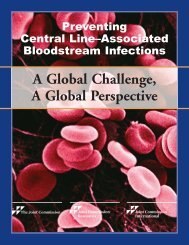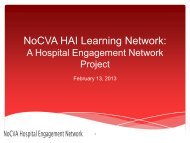Improving Surveillance for Ventilator-Associated Events in Adults
Improving Surveillance for Ventilator-Associated Events in Adults
Improving Surveillance for Ventilator-Associated Events in Adults
Create successful ePaper yourself
Turn your PDF publications into a flip-book with our unique Google optimized e-Paper software.
NHSN <strong>Surveillance</strong> <strong>for</strong> <strong>Ventilator</strong>-<strong>Associated</strong> <strong>Events</strong> <strong>in</strong> <strong>Adults</strong><br />
What progress has the Work<strong>in</strong>g Group made<br />
• The Work<strong>in</strong>g Group has proposed a new surveillance def<strong>in</strong>ition algorithm to detect VAEs <strong>in</strong> adult patients. It is not<br />
designed <strong>for</strong> use <strong>in</strong> the cl<strong>in</strong>ical care of patients. The Work<strong>in</strong>g Group anticipates that the new def<strong>in</strong>ition algorithm<br />
will cont<strong>in</strong>ue to be ref<strong>in</strong>ed, based on the results of field experience and additional research. The def<strong>in</strong>ition<br />
algorithm ref<strong>in</strong>ement process is, and will cont<strong>in</strong>ue to be iterative, and will require the ongo<strong>in</strong>g engagement of the<br />
critical care, <strong>in</strong>fection prevention, <strong>in</strong>fectious diseases and healthcare epidemiology communities.<br />
What is the new, proposed NHSN surveillance def<strong>in</strong>ition algorithm<br />
• The def<strong>in</strong>ition algorithm (presented on page 3) is only <strong>for</strong> use with the follow<strong>in</strong>g patients:<br />
o Patients ≥ 18 years of age;<br />
o Patients who have been <strong>in</strong>tubated and mechanically ventilated <strong>for</strong> at least 3 calendar days; and<br />
o Patients <strong>in</strong> acute and long-term acute care hospitals and <strong>in</strong>patient rehabilitation facilities.<br />
• NOTE: Patients receiv<strong>in</strong>g rescue mechanical ventilation therapies (e.g., high-frequency ventilation, extracorporeal<br />
membrane oxygenation, or mechanical ventilation <strong>in</strong> the prone position) are excluded from surveillance us<strong>in</strong>g the<br />
new, proposed def<strong>in</strong>ition algorithm.<br />
How is the new surveillance def<strong>in</strong>ition algorithm different from the current PNEU def<strong>in</strong>itions<br />
• The new algorithm: 1) will detect ventilator-associated conditions and complications, <strong>in</strong>clud<strong>in</strong>g (but not necessarily<br />
limited to) VAP; 2) requires a m<strong>in</strong>imum period of time on the ventilator; 3) focuses on readily-available, objective<br />
cl<strong>in</strong>ical data; and 4) does not <strong>in</strong>clude chest radiograph f<strong>in</strong>d<strong>in</strong>gs.<br />
Why are chest radiographs not <strong>in</strong>cluded <strong>in</strong> the new surveillance def<strong>in</strong>ition algorithm<br />
• Evidence suggests that chest radiograph f<strong>in</strong>d<strong>in</strong>gs do not accurately identify patients with VAP. Furthermore, the<br />
variability <strong>in</strong> radiograph order<strong>in</strong>g practices, technique, <strong>in</strong>terpretation, and report<strong>in</strong>g make chest radiograph<br />
f<strong>in</strong>d<strong>in</strong>gs less well-suited <strong>for</strong> <strong>in</strong>clusion <strong>in</strong> an objective, reliable surveillance def<strong>in</strong>ition algorithm to be used <strong>for</strong> public<br />
report<strong>in</strong>g and <strong>in</strong>ter-facility comparisons of event rates and pay-<strong>for</strong>-report<strong>in</strong>g and -per<strong>for</strong>mance programs.<br />
How will I f<strong>in</strong>d cases us<strong>in</strong>g the new algorithm<br />
• CDC is work<strong>in</strong>g on operational guidance to help healthcare facility staff implement the new algorithm <strong>for</strong> electronic<br />
or manual event detection, once it is ready <strong>for</strong> deployment <strong>in</strong> NHSN. A possible method to make VAE surveillance<br />
more efficient is to organize data elements <strong>in</strong> a flow sheet at the patient’s bedside. In the example below, the<br />
shaded area highlights the period dur<strong>in</strong>g which a possible VAP event is detected.<br />
VentDay PEEPm<strong>in</strong> FiO 2 m<strong>in</strong> Tm<strong>in</strong> Tmax WBCm<strong>in</strong> WBCmax Antimicrobials Spec Polys Epis Organism<br />
1 10 60 37.9 38.1 12.1 14.2 None -- -- -- --<br />
2 5 40 37.1 37.5 11.8 11.8 None -- -- -- --<br />
3 5 40 36.9 37.6 12.1 12.1 None ETA ≥25/lpf





